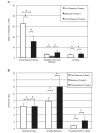Videotaped behavior as a predictor of clinical outcome in rhesus macaques (Macaca mulatta)
- PMID: 24956211
- PMCID: PMC4067583
Videotaped behavior as a predictor of clinical outcome in rhesus macaques (Macaca mulatta)
Abstract
Understanding the behavior of laboratory NHP facilitates health assessment and clinical care. We sought to characterize the behavior of critically ill rhesus macaques (Macaca mulatta) and determine whether specific behaviors or behavioral changes might facilitate the determination of prognosis and clinical endpoints. Twenty-two critically-ill subjects were videorecorded after they were removed from the outdoor breeding colony for diagnostic work-up and treatment. Subjects were categorized as survivors (n = 15) and those that were euthanized according to existing clinical endpoints (n = 7). Behavior before, during, and after cageside examination was compared between these groups with regard to the presence or absence of direct observation. This approach allowed us to determine whether these settings revealed differences between groups or masking of behaviors during direct observation. Before cageside examination, several behaviors (for example, self-grooming and anxiety behaviors) were significantly more common in surviving subjects than in euthanized subjects. Few significant differences in behavior were detectable during or after the examination. Subjects that were eventually euthanized showed more illness-related behaviors; however, not all animals requiring euthanasia showed these signs when an observer was present. Furthermore, euthanized animals spent more time in an alert posture during direct observation than at other times. Therefore, direct observation of critically ill rhesus macaques may not yield the most accurate assessment of illness severity, and using video to assess behavior may be helpful for prognosis.
Figures






Similar articles
-
Hypercortisolemia and Depressive-like Behaviors in a Rhesus Macaque (Macaca mulatta) Involved in Visual Research.Comp Med. 2017 Dec 1;67(6):529-536. Comp Med. 2017. PMID: 29212586 Free PMC article.
-
Correction of refractive errors in rhesus macaques (Macaca mulatta) involved in visual research.Comp Med. 2014 Aug;64(4):300-8. Comp Med. 2014. PMID: 25427343 Free PMC article.
-
Severity and Distribution of Wounds in Rhesus Macaques (Macaca mulatta) Correlate with Observed Self-Injurious Behavior.J Am Assoc Lab Anim Sci. 2015 Sep;54(5):516-20. J Am Assoc Lab Anim Sci. 2015. PMID: 26424249 Free PMC article.
-
Effects of outdoor housing on self-injurious and stereotypic behavior in adult male rhesus macaques (Macaca mulatta).J Am Assoc Lab Anim Sci. 2006 Sep;45(5):35-43. J Am Assoc Lab Anim Sci. 2006. PMID: 16995645
-
Intestinal parasitism in an outdoor breeding colony of Macaca mulatta.Lab Anim Sci. 1981 Jun;31(3):282-5. Lab Anim Sci. 1981. PMID: 7265909
Cited by
-
Pharmacokinetics of Single-Dose Intramuscular and Subcutaneous Injections of Buprenorphine in Common Marmosets (Callithrix jacchus).J Am Assoc Lab Anim Sci. 2021 Sep 1;60(5):568-575. doi: 10.30802/AALAS-JAALAS-20-000151. Epub 2021 Jul 19. J Am Assoc Lab Anim Sci. 2021. PMID: 34281629 Free PMC article.
-
The Promise of Behavioral Tracking Systems for Advancing Primate Animal Welfare.Animals (Basel). 2022 Jun 27;12(13):1648. doi: 10.3390/ani12131648. Animals (Basel). 2022. PMID: 35804547 Free PMC article. Review.
-
Hinge-deleted IgG4 blocker therapy for acetylcholine receptor myasthenia gravis in rhesus monkeys.Sci Rep. 2017 Apr 20;7(1):992. doi: 10.1038/s41598-017-01019-5. Sci Rep. 2017. PMID: 28428630 Free PMC article.
-
Hypercortisolemia and Depressive-like Behaviors in a Rhesus Macaque (Macaca mulatta) Involved in Visual Research.Comp Med. 2017 Dec 1;67(6):529-536. Comp Med. 2017. PMID: 29212586 Free PMC article.
-
Investigating subtle changes in facial expression to assess acute pain in Japanese macaques.Sci Rep. 2022 Nov 16;12(1):19675. doi: 10.1038/s41598-022-23595-x. Sci Rep. 2022. PMID: 36385151 Free PMC article.
References
-
- Animal Welfare Regulations. 2008. 9 CFR § 3.129.
-
- Benjamini Y, Hochberg Y. 1995. Controlling the false-discovery rate: a practical and powerful approach to multiple testing. J Royal Statist Soc B (Methodological) 57:289–300
-
- Bohm RP, Gilbert MH. 2012. Emergency medicine and critical care for nonhuman primates, p 359–389. In: Abee CR, Mansfield K, Tardif S, Morris T, editors. Nonhuman primates in biomedical research: biology and management, vol 1. Waltham (MA)): Elsevier.
-
- Canadian Council on Animal Care. 1998. Guidelines on choosing an appropriate endpoint in experiments using animals for research, teaching, and testing
-
- Capitanio JP. 2011. Nonhuman primate personality and immunity: mechanisms of health and disease, p 233–255. In: Weiss A, King JE, Murray L, editors. Personality and temperament in nonhuman primates, vol 1. New York (NY): Springer.
Publication types
MeSH terms
Grants and funding
LinkOut - more resources
Full Text Sources
